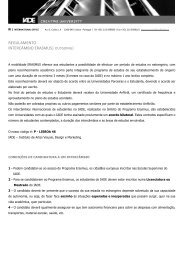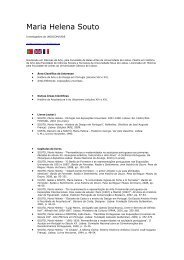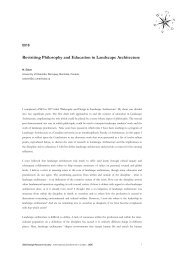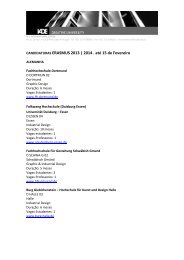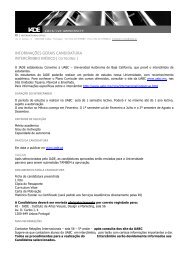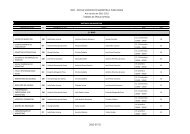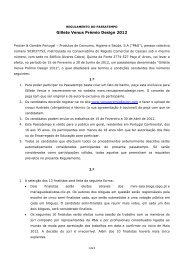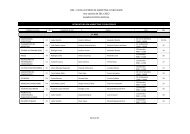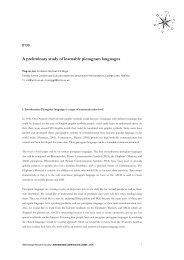0053 Conventions of Typography Related to Traditional Poetry - IADE
0053 Conventions of Typography Related to Traditional Poetry - IADE
0053 Conventions of Typography Related to Traditional Poetry - IADE
You also want an ePaper? Increase the reach of your titles
YUMPU automatically turns print PDFs into web optimized ePapers that Google loves.
ingenuity can control’ (Thorpe, 1950:22). However, he still prefers <strong>to</strong> have some control within such a text; he<br />
suggests that printers can control spacing between words in order <strong>to</strong> make the line longer or shorter. Since<br />
such books are dedicated <strong>to</strong> discussing an area which gives edi<strong>to</strong>rs more control than authors, it is logical and<br />
understandable that they focus on prose issues mainly because they clearly cannot suggest typographical rules<br />
for unpredictable forms <strong>of</strong> poetry. However, when the layout <strong>of</strong> a text is determined by a person who is not<br />
involved in the production <strong>of</strong> the book, in this case, the poet, his decisions impact on the edi<strong>to</strong>r’s<br />
typographical choices.<br />
The line length is one such typographical choice which is an essential part <strong>of</strong> written and printed poetry, but<br />
there are a number <strong>of</strong> other typographical features, such as indentation, the alignment <strong>of</strong> the poem on the<br />
page, the use <strong>of</strong> capital letters and the blank spaces within the poem which are also significant in defining the<br />
typography <strong>of</strong> poetry. Models and rules which poets have followed throughout the centuries are found in the<br />
traditional forms <strong>of</strong> poetry. Such traditional forms can be seen in traditional stanza forms such as terza rima,<br />
rhyme royal or Spenserian stanza, and traditional poem forms, such as the Shakespearean sonnet, the Spenserian<br />
sonnet and the ballade.<br />
It has been seen how printers’ manuals, manuals <strong>of</strong> style and books about typography do relate <strong>to</strong> poetry in an<br />
inconsistent way. They include comments on several useful features. In order <strong>to</strong> look closely at these features,<br />
the following section will concentrate on rules and prescriptions within the twentieth-century material<br />
identified in the previous section, as these provide a fuller source <strong>of</strong> information than manuals from the<br />
previous centuries.<br />
Advice for typesetting poetry within twentieth century manuals<br />
Common suggestions and rules<br />
The twentieth-century manuals and the books about typography show how poetry has been, or can be, set on<br />
the page, without explaining especially why such procedures are recommended. There are two ways in which<br />
suggestions and rules are written: some authors advocate rigid methods <strong>of</strong> displaying poetry on the page, whilst<br />
others are more flexible in their approach. For example, as regards the use <strong>of</strong> capital letters, De Vinne (1902)<br />
argues that the poem must use the capital letter at the beginning <strong>of</strong> each line. Simon (1945) is basically <strong>of</strong> the<br />
same opinion, however he says that the poet’s manuscript has <strong>to</strong> be respected. Hart and Ritter (2002:445) are<br />
also flexible because they suggest ‘do not au<strong>to</strong>matically impose capitals at the beginnings <strong>of</strong> lines’. They remind<br />
their readers that this is a tradition from Greek and Latin poetry and that modern verse is <strong>of</strong>ten written with<br />
lower case letters at the beginning <strong>of</strong> lines.<br />
They suggest following the original manuscript. R. A. Hewitt (1957:96) in a section called ‘Without exceptions’,<br />
states that printers should ‘capitalise the first word in each line <strong>of</strong> poetry in English’. He claims that there<br />
should be no exception <strong>to</strong> this rule ‘unless the poet has ultra-modern ideas’.<br />
One <strong>of</strong> the features most <strong>of</strong>ten commented on relates <strong>to</strong> page layout. Most <strong>of</strong> the books listed in the<br />
introduction discuss the alignment <strong>of</strong> the poem on the page (Chicago manual <strong>of</strong> style, 1993; Simon, 1945;<br />
Williamson, 1956; Hart, 1983; Ritter, 2002; McLean, 1980; De Vinne, 1902; Bringhurst, 1992; Tschichold,<br />
1967). Some are concerned with the balance <strong>of</strong> facing pages (McLean, 1980 and Newdigate in Thorpe, 1950).<br />
Others discuss the importance <strong>of</strong> the shape relating <strong>to</strong> rhythm (Simon, 1945; The Chicago manual <strong>of</strong> style, 1993;<br />
2006 Design Research Society . International Conference in Lisbon . <strong>IADE</strong> 4





